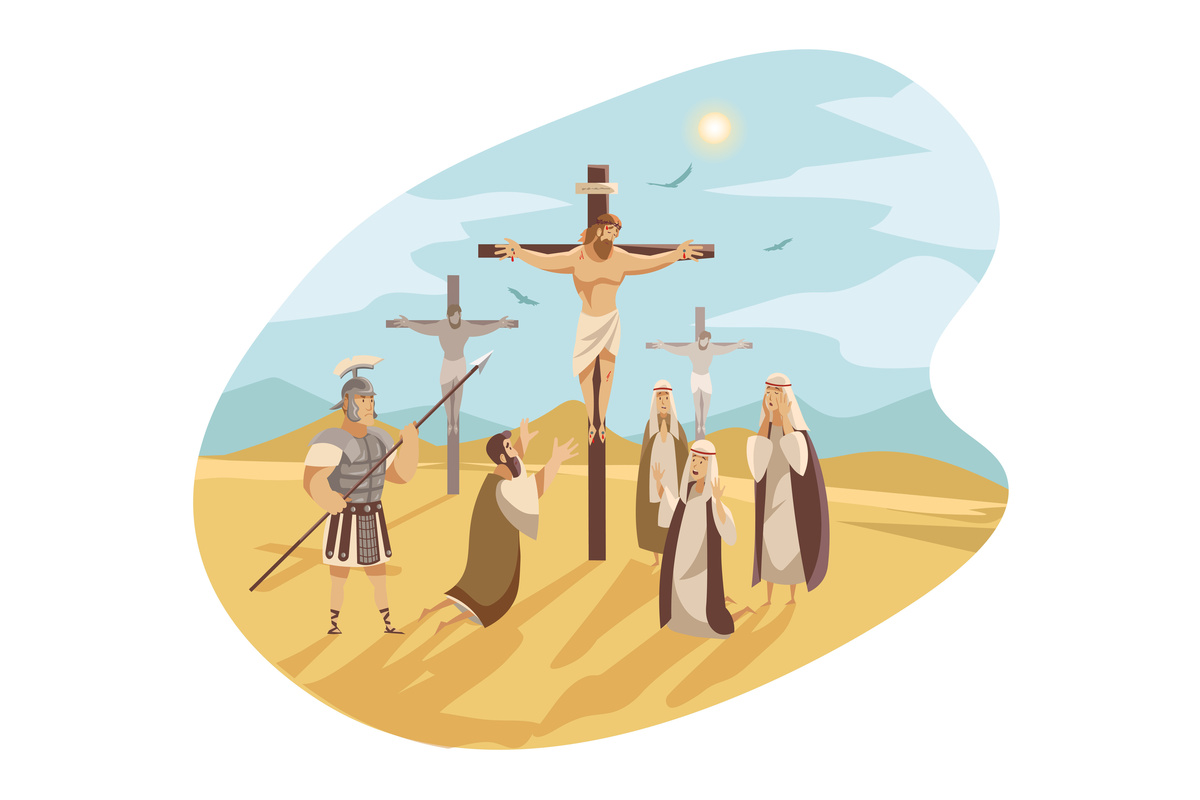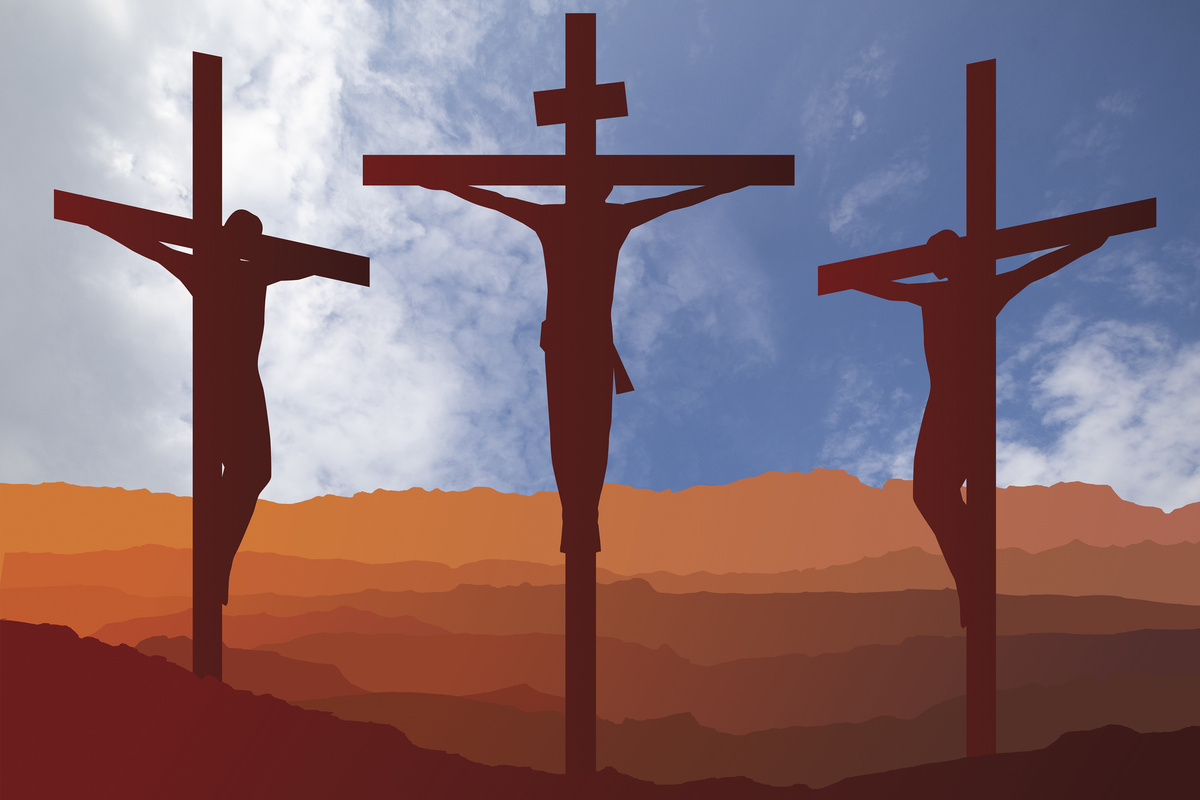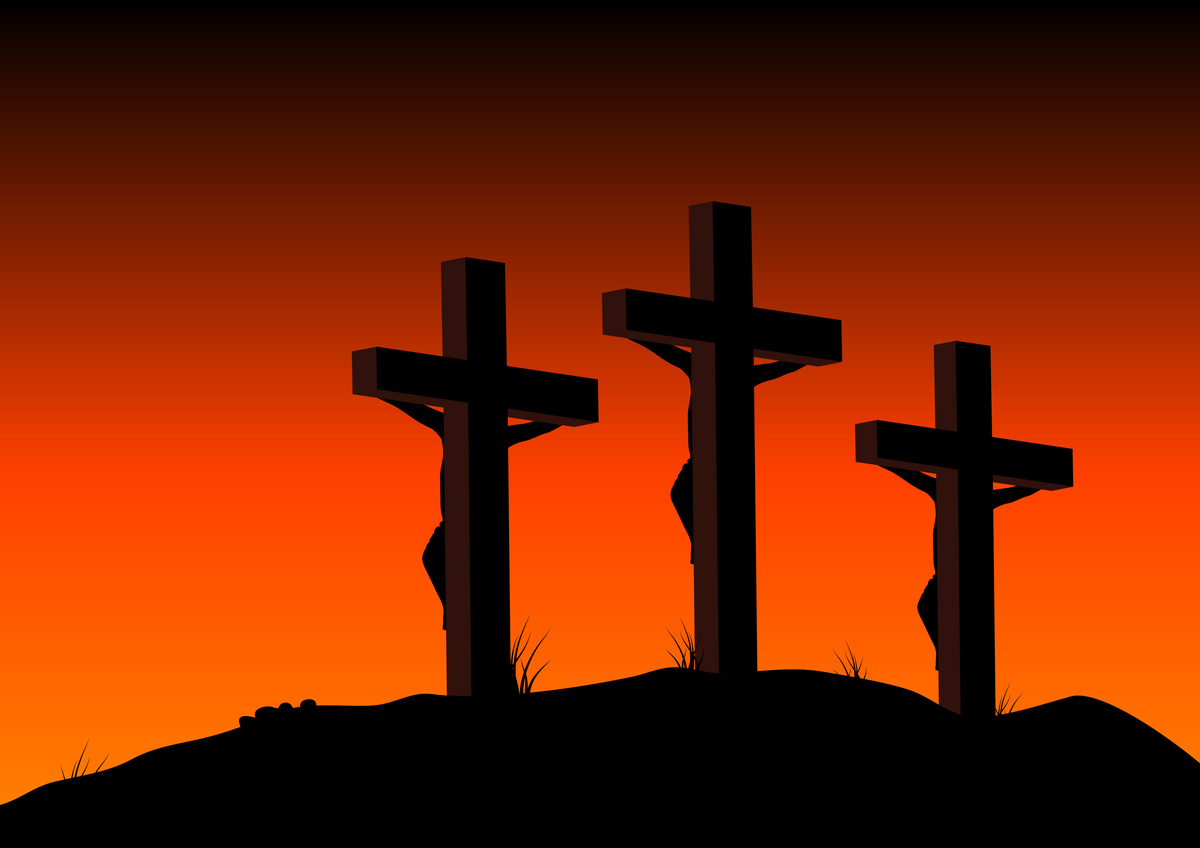Table of contents
What is the importance of Saint Dimas?

Saint Dimas is considered the first catholic saint. Although his name is not in the wills, Saint Dimas was canonized by Jesus Christ himself at the moment of crucifixion.
This saint brings us an important message about the need to offer your life to God, regardless of when you do it. After all, there is no sooner or later for the Almighty.
In this article we will bring more information about the history of Saint Dimas, his worship and also a prayer to connect with the protector of the poor and dying. Read and learn more!
Knowing Saint Dimas, the good thief

Saint Dimas, also known as the good thief, has an incredible story, full of twists and turns. Do you know that it was Dimas who protected Jesus when he was still a baby?
And even more impressive: Dimas and Jesus met again 30 years later at the moment of crucifixion. Read and discover the whole story of this saint!
Origin and history of São Dimas
Dimas was an Egyptian thief, who together with Simas robbed travelers in the desert. His path crossed that of Jesus Christ when he, still a baby, fled with his family from the persecution of King Herod.
Simas and Dimas would rob the Holy Family, but Dimas decided to protect the family, sheltering Baby Jesus, Mary and Joseph. Years later, during the crucifixion of Jesus Christ, Dimas and another thief were by his side.
The other bandit mocked Jesus, asking why he was not saved, since he was the Christ. Dimas, however, rebuked him, confessing his guilt and recognizing him as King. The good thief also asked Jesus to remember him when he ascended to heaven.
Crimes and death of the good thief
Crucifixion was applied by the Romans as punishment for the most serious transgressions committed by criminals, gladiators, military deserters, subversives and slaves. This type of punishment was directly associated with the severity of the offense committed by the defendant.
Due to the penalty received, it is possible to affirm that Dimas was a dangerous thief of the time. He received the torture on the cross, which was applied only to the worst bandits. It was inevitable, then, his punishment.
But, also at the same time that he was captured and punished, Dimas has the opportunity to be reunited with Jesus. And, according to the scriptures, he was aware of his guilt. In Luke 23:39-43, Dimas speaks to the thief who blasphemed against Jesus:
"Do you not even fear Allah, being under equal sentence? We indeed justly; for we receive the punishment our deeds deserve."
At this moment, Dimas still recognizes Jesus as King and his sinless life:
"[...] but this one did no harm. And he said unto him, Jesus, remember me when thou comest in thy kingdom. Jesus answered him, Verily I say unto thee, To day shalt thou be with me in paradise."
Thus, Dimas was the first to enter in the Kingdom of Heaven next to Christ, as well as the first saint. Since then, Dimas became known as the good thief, or Saint Dimas.
Visual characteristics of Rakh
Saint Dimas is known in the Orthodox Church as Rakh, which means "the one born in the sunset". Actually, this name refers more to the moment when he confesses and is forgiven by Jesus Christ, than his baptismal name.
Generally, Saint Dimas is represented as a white man and curly hair holding a cross, or being crucified. There are still other portraits that show the Saint in the Paradise next to Jesus.
According to the symbolism of the Orthodox Church, the birth in the sunset is a representation for the rebirth of Saint Dimas in the moment he professes his faith in Christ. It carries, thus, a message about the ultimate grace.
What does São Dimas represent?
Saint Dimas is revered as the patron saint of men who have committed felonies and are imprisoned, or have been convicted, of thieves repenting for their crimes, or of funeral directors who are responsible for the burial of people.
Therefore, he is the protector of sinners, especially those who in the last moments repent and ask for forgiveness. His life and death tell us about the mercy of Christ, who even knowing the sins of Dimas, allowed him to enter the Kingdom of Heaven with Him.
Thus, Saint Dimas represents the goodness and forgiveness, which we should not only expect from the Creator, but also practice in our lives, as Christ said to Peter in Matthew 18:21-22:
"Then Peter came to Jesus and said, "Lord, how many times shall I forgive my brother when he sins against me, even seven times?"
Jesus answered:
"I say unto you, Not unto seven, but unto seventy times seven."
Day and celebrations to Saint Dimas
The feast day of Saint Dimas is on March 25, considered the day he professed his faith to Jesus Christ. So, all around the world is celebrated the day of Saint Dimas, the first Catholic Saint.
The celebrations are made with pilgrimages, feasts and masses. March 25th is considered not only the day of Christ's crucifixion, but also the crucifixion of Dimas himself, who with the forgiveness of Jesus ascended by his side to heaven. Therefore, it is a day full of reflections and prayers for the Christians.
Devotion to Saint Dimas around the world
In addition to the processions and festivities on the day of Saint Dimas, there are several churches and chapels in honor of the saint. Moreover, in the Church of the Holy Cross of Jerusalem, in Rome, it is possible to visit a piece of the arm of the cross where Saint Dimas was killed.
Devotion to Saint Dimas in Brazil
In Brazil, a parish was built in honor of the saint in São José dos Campos, where a Sanctuary was also made. The parish of the Saint of Calvary was elevated to a cathedral, the so-called Diocese of São José dos Campos.
Inclusively, in this cathedral there is a small piece of the arm of the cross where the Good Thief was nailed. In the city of São Paulo was also erected the Parish of São Dimas in the district of Vila Nova Conceição.
Thus, in several cities there is the adoration of Saint Dimas, especially on March 25, when several churches around the country celebrate the day of the first saint.
Symbologies of Saint Dimas

Saint Dimas was revealed in several ways, but all of them carry the same message of mercy and forgiveness. Despite not being mentioned in the biblical books, Dimas and Simas are relevant in the apocryphal gospels.
In this section, you will discover which is the representation of Saint Dimas in the Catholic Church, Orthodox, Umbanda and much more. Read and understand!
Saint Dimas in the Catholic Church
For the Catholic Church, Saint Dimas became patron saint of sinners, of those who converted at the last moment. He is, moreover, the saint of difficult causes, of the dying poor and of those of difficult salvations, like addicts.
He is also the protector of prisoners, penitentiaries and morticians. His holiness also protects homes from burglary and brings a good death to those who repent.
Saint Dimas in the Orthodox Church
Dimas was represented with other names in other Churches. In the Orthodox, for example, he is called Rakh, while for the Arabs he is known as Tito. However, the name in no way changes his message.
Saint Dimas in Umbanda
There is no record of syncretism of São Dimas in Umbanda or Candomblé. However, some practitioners of this religion consider that the representation of São Dimas in the religions of African matrix would be with Zé Pilintra, patron entity of the bars, gambling places, the street, the good rascal.
Saint Dimas in the Bible
The name of Dimas does not appear at any time in the Bible. However, his presence is verified in the book of Luke 23:39-43, when narrating the moment of Christ's crucifixion. The apostle relates that Jesus was crucified between two thieves, one that blasphemed and another that defended him:
39 Then one of the malefactors which were hanged up railed on him, saying, Art thou not the Christ? save thyself and us.
40 But the other answered and rebuked him, saying, Dost thou not even fear God, seeing thou art in the same condemnation?
41 And we indeed justly; for we receive what our deeds deserve; but this man hath done no evil.
42 Then said he, Jesus, remember me when thou comest into thy kingdom.
43 Jesus answered and said unto him, Verily I say unto thee, To day shalt thou be with me in paradise.
Thus, Saint Dimas is considered the good thief for being next to Christ in the crucifixion, and recognize his sins.
Saint Dimas in the apocryphal gospels
Despite not appearing in the biblical books, the name of Dimas is mentioned in the so-called apocryphal gospels. These books describe the life of Jesus Christ, but are not considered legitimate by the Catholic Church and, therefore, are not part of the complicated of books called Bible.
Some of them are not considered for not having authorship, as in the case of the apocryphal gospels, and others have different information from the present in the other biblical texts. In the case of the Gospel of Nicodemus, an apocryphal of the IV century, the name of Dimas appears for the first time.
It is also possible to find accounts of the good thief in the Acts of Pilate, a Latin version where the name of the other thief, Gestas, is also revealed. In a third gospel, the Arabic Gospel of the Infancy of Jesus, another apocryphal of the sixth century, the encounter of Jesus and his family with two thieves, named Titus and Dumachus, is reported.
Saint Dimas in popular culture
The influence of Saint Dimas is such that he has been represented in popular culture several times. The Brazilian rap group Racionais MC's, for example, refers to Dimas as "the first vida loka of history" in the song Vida Loka II, from the album "Nothing like a day after another day".
Already in the album "Recanto", composed by Caetano Veloso and performed by Gal Costa, the song "Miami maculelê" refers to several historical characters who are represented as "good thieves", such as São Dimas, Robin Hood and Charles, Angel 45.
Other information about São Dimas

There is still other precious information about Saint Dimas that help us to understand his trajectory and the symbolism of his martyrdom on the cross. Moreover, it is also important to understand more about the role of Gestas, or Simas, the other thief who blasphemed against Jesus. Want to know more? Keep reading!
Interesting facts about São Dimas
One of the most remarkable facts about Saint Dimas is that he was canonized by Jesus Christ himself, thus becoming the first Catholic saint and also the first to enter the kingdom of heaven.
It is also important to note the anonymity of Dimas in the Bible, and to understand that not only famous saints carry important messages. The story of Dimas also brings to light the various gospels that are not considered part of the Bible and that can reveal interesting stories and learning.
A little about Gestas
Gestas, also called Simas, was the other thief crucified with Jesus and Dimas. He is considered the bad thief, the one who blasphemed and did not repent even at the hour of death.
Despite his role being seen as bad, Gestas also brought lessons in his attitude. It is important to observe how we fail to make the right decision, often out of pride.
Dimas, unlike Gestas, recognized his mistakes and sins and asked for a new chance, even knowing that he would not have this chance in life, but only in the kingdom of Christ.
Prayer of Saint Dimas
There are several prayers to Saint Dimas and generally they report the goodness and mercy of Christ to forgive the sinner. They also ask that Christ, as he remembered Dimas, remember them at the time of his death. Follow one of these prayers:
Saint Dimas, that you had the happiness to hear from the lips of Jesus crucified this word of salvation: today you will be with me in paradise, and that full of a great trust in the merciful love of Jesus, dared to ask: "Lord, remember me when you entered in your Kingdom" and achieved the in a saint and a martyr; glorious Saint Dimas, your living faith and our contradiction in the last hour, youwere worth such grace.
We too, poor sinners, through the wounds of Jesus crucified and the sufferings of your Mother, Mary most holy, pray to you and hope to obtain divine mercy in life, and especially at the hour of death.
And for such a grace to be granted to us, we implore your valuable protection. O Dimas, you were the good thief that, stealing heaven and conquering the agonizing and merciful heart of Jesus, became the model of trust, and of the repentant sinners.
Help us, Saint Dimas, in all our afflictions and needs, temporal and spiritual! Especially in that last hour, when our agony comes, ask Jesus crucified and dead for our salvation, may we have your repentance and confidence, and also, like you, hear the consoling promise: "Today you will be with me in paradise".
Saint Dimas is the protector of the poor and dying!

The main message brought by Dimas is the message of faith. Saint Dimas was a sinner, just like all of us, but he was not afraid or ashamed to proclaim his faith, even when many would judge it to be too late.
The protector of the poor, dying and sinners also carries the message of divine mercy and the compassion of Christ, who seeing his suffering and his repentance forgave him.
Despite his anonymity in the sacred books, Dimas must always be present in our supplications. It is important to ask the first of the saints wisdom in their actions to avoid sins and, when they happen, enough humility to confess and repent for them.
Now that you know the message of Dimas, his history and legacy, be sure to include the prayer for this Saint in your day to day!

